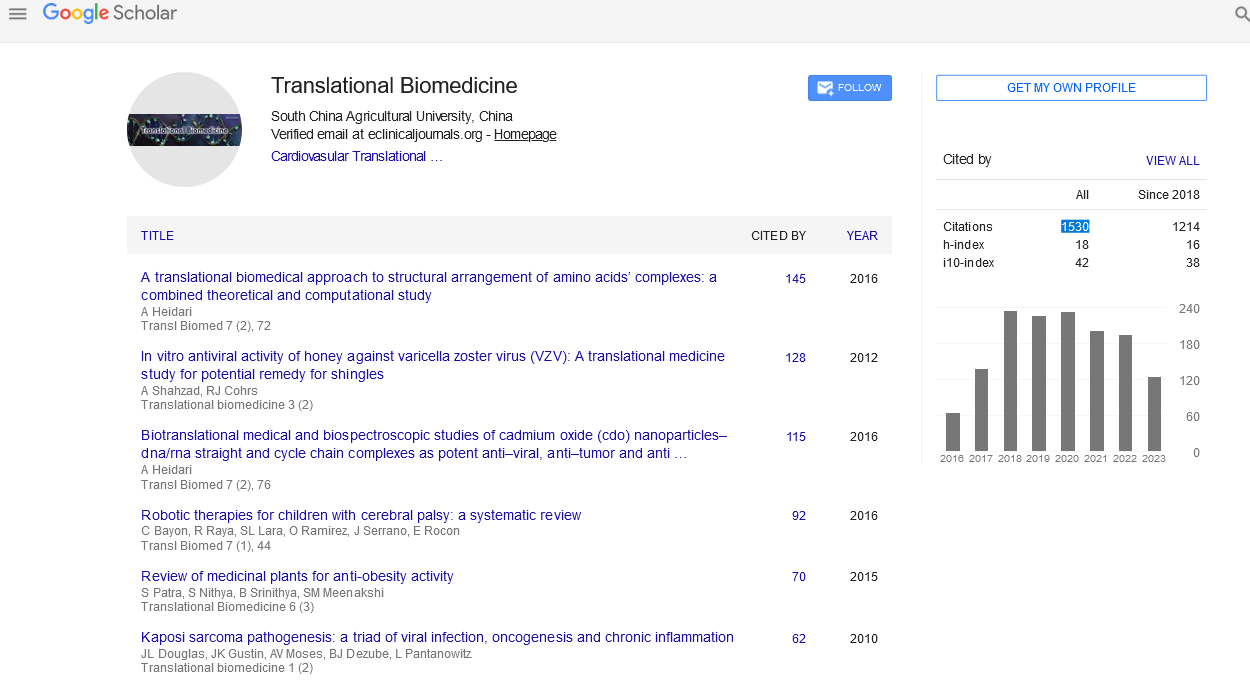Review Article - (2023) Volume 14, Issue 3
Slim-Prim: A Database for Biomedical Informatics to Support Translational Research
Robert Alam*
Department of Translational Research, Ethiopia
*Correspondence:
Robert Alam, Department of Translational Research,
Ethiopia,
Email:
Received: 01-Mar-2023, Manuscript No. Iptb-23-13609;
Editor assigned: 03-Mar-2023, Pre QC No. Iptb-23-13609 (PQ);
Reviewed: 16-Mar-2023, QC No. Iptb-23-13609;
Revised: 20-Mar-2023, Manuscript No. Iptb-23-13609 (R);
Published:
27-Mar-2023, DOI: 10.36648/2172- 0479.14.03.289
Abstract
Slim-Prim, an integrated data system (IDS) for collecting, processing, archiving, and disseminating data from basic and clinical research, was developed in response to this challenge. Slim-Prim is accessed through user-friendly Web�based applications, removing the security risks associated with office or laboratory servers and increasing data accessibility. For institutional projects, Slim-Prim is a laboratory management interface and archive data repository. Importantly, de�identified data can be shared and analysed across research domains in a HIPAA�compliant manner thanks to multiple levels of controlled access. As a result, Slim�Prim fosters clinical and academic collaboration, which is crucial to the growth of translational research. Slim-Prim is an illustration of how IDS can be used to bridge the gap between laboratory discovery and practice and increase organizational efficiency.
Keywords
Bioinformatics; Health management; Clinical trial, Basic research;
Laboratory management; Data sharing
Introduction
Clinical research and patient care can become more interconnected
and interactive thanks to technology. Basic and clinical researchers
collaborate on the interpretation and application of research
data in clinical settings in what is known as translational science.
Sharing data is essential for accelerating biomedical science's
progress from the bench to the bedside to the community and
improving healthcare quality. To go from clinical examination to
local area practice, incorporated information frameworks should
be made to permit local area scientists to get to get and classified
research information without any problem [1]. After that, these
data can be used to respond to questions that are relevant to
particular communities and can be extrapolated to the national
level. Moreover, data can be absorbed for local area training
to assist with further developing medical services. To address
information incorporation issues, the Logical Lab Data The
executives Patient-care Exploration Data The board Thin Demure
framework was created by the Biomedical Informatics Unit at the
College of Tennessee Wellbeing Science Center [2]. The Public
Foundations of Wellbeing NIH "Guide" recognized an absence
of correspondence among fundamental and clinical researchers
as a significant detour to the improvement of translational
seat to bedside innovations. The "Roadmap" emphasized the
requirement for novel bioinformatics solutions to address this
issue and promote collaboration between clinicians and basic
scientists. The initial need at UTHSC to integrate data from basic
science and clinical research prompted the development of the
Slim-Prim system [3]. At the University of Tennessee, a growing
number of clinicians and faculty members are utilizing the Slim-
Prim system for their own research. Take a look at the Slim-Prim
system's schematic overview.
Improvement of the thin demure
framework: metadata
Metadata design is clearly the most important factor in producing
effective query results, such as searching results, data grouping
for integration, correct manipulation, and so on. In addition to
handling data in a variety of formats and for data storage and
retrieval, searching, sorting, and reporting, the attributes in the
metadata are designed to contain all essential identification keys
[4]. Names, descriptions, keywords, control vocabulary, data
type, and other fields necessary for future mapping, integration,
and navigation are included in metadata, for instance. The
metadata table specifies the data type that is used to store the attribute values in the table. All the quality portrayals and values
can likewise be connected along with related ID keys.
Tool for screening patients and research subjects
We've found that prospective subjects are more likely to use a
website to learn about clinical trials and the requirements for
enrolment than they are to use more conventional methods.
The purpose of the patient recruiting and research subject
screening tool is to pre-screen and validate subjects for research
as well as inform and inspire potential participants. Potential
subjects' data are stored and reported to data coordinators for
validation and review [5]. The system provides subjects with
a private questionnaire that meets the clinical investigator's
predetermined criteria for prequalification. If the person does
not meet the requirements for the study, they are informed
right away. Recruiters have more time to speak with legitimate
participants as a result of the Web application's ability to identify
suitable subjects. In the event that they do qualify, the framework
gives a rundown of preliminary locales, phone numbers, and a
guide to the picked area.
Combining data from a variety of sources
Researchers can review data in accordance with their research
design thanks to this. For instance, the Department of Health
and Human Services' Healthcare Cost and Utilization Project
(HCUP) provided 10 years' worth of triennial data from the Kids'
Inpatient Database [6]. This data was then converted from ASCII
to CSV and uploaded into the Slim-Prim system. Nearly seven
million pediatric hospital discharges from patients with a variety of diagnoses and comorbidities are represented by these data.
In order to limit the data set, the Slim-Prim report system also
allows complex queries. For statistical analysis using the user's
preferred software, the data can be downloaded in Excel spread
sheet format.
Discussion
It is abundantly clear that the clinical and translational research
communities require a Web application that facilitates quick data
sharing among laboratories and institutions and provides simple
access to data. These tools need to be made with security and
strict research compliance in mind; As a result, the Slim-Prim
system's primary components include robust access levels. Slim-
Prim makes scientific laboratory management easier and more
effective by letting researchers customize their own applications
to collect data in a variety of formats about lab materials, tools, and
budgets [7]. For data collection, storage, retrieval, searching, and
reporting, this system also makes use of patient-care information
tools like online screening forms, online applications, medical
forms, and patient folders that contain demographic, laboratory,
and historical data. Importantly, the system's expandability and
modularity make it possible to store data from a variety of fields,
including rehabilitation data, DNA sequencing files, and radiology
and image file data. The purpose of these scientific and patientcare
informational tools is to make community research easier
and to encourage collaboration with other researchers and
communities.
References
- Wang K, Tarczy-Hornoch P, Shaker R, Mork P, Brinkley JF (2005) Bio Mediator Data Integration: Beyond Genomics to Neuroscience Data. AMIA Annual Symposium Proceedings 779–783.
Indexed at, Google Scholar
- Brazhnik O, Jones J (2007) Anatomy of Data Integration. J Biomed Inform 40:252–269.
Indexed at, Google Scholar, Crossref
- Dinu V, Nadkarni P (2007) Guidelines for the Effective Use of Entity Attribute–Value Modeling for Biomedical Databases. Int J Med Inform 76: 769–779.
Indexed at, Google Scholar, Crossref
- Deshpande AM, Brandt C, Nadkarni PM (2002) Metadata-driven Ad Hoc Query of Patient Data. J Am Med Inform Assoc 9:369–382.
Indexed at, Google Scholar, Crossref
- Corwin J, Silberschatz A, Miller PL, Marenco L (2006) Dynamic Tables: Architecture for Managing Evolving, Heterogeneous Biomedical Data in Relational Database Management Systems. J Am Med Inform Assoc 14:86–93.
Indexed at, Google Scholar, Crossref
- Jean S, Ait-Ameur Y, Pierra G (2006) Querying Ontology Based Database Using OntoQL (An Ontology Query Language). On the Move to Meaningful Internet Systems 4275:704–721.
Indexed at, Google Scholar, Crossref
- Fisk JM, Mutalik P, Levin FW, Erdos J, Taylor C et al. (2003) Integrating Query of Relational and Textual Data in Clinical Databases. J Am Med Inform Assoc 10: 21–38.
Indexed at, Google Scholar, Crossref
Citation: Alam R (2023) Slim-Prim: A Database for Biomedical Informatics to Support Translational Research. Transl Biomed, Vol. 14 No. 3: 114.





